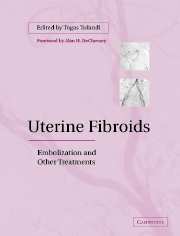Book contents
- Frontmatter
- Contents
- Contributors
- Preface
- Foreword
- 1 Uterine fibroids: epidemiology and an overview
- 2 Histopathology of uterine leiomyomas
- 3 Imaging of uterine leiomyomas
- 4 Abdominal myomectomy
- 5 Laparoscopic managment of uterine myoma
- 6 Hysteroscopic myomectomy
- 7 Myomas in pregnancy
- 8 Expectant and medical management of uterine fibroids
- 9 Hysterectomy for uterine fibroid
- 10 History of embolization of uterine myoma
- 11 Uterine artery embolization – vascular anatomic considerations and procedure techniques
- 12 Pain management during and after uterine artery embolization
- 13 Patient selection, indications and contraindications
- 14 Results of uterine artery embolization
- 15 Side effects and complications of embolization
- 16 Reproductive function after uterine artery embolization
- 17 Reasons and prevention of embolization failure
- 18 Future of embolization and other therapies from gynecologic perspectives
- 19 The future of fibroid embolotherapy: a radiological perspective
- Index
- Plate section
4 - Abdominal myomectomy
Published online by Cambridge University Press: 10 November 2010
- Frontmatter
- Contents
- Contributors
- Preface
- Foreword
- 1 Uterine fibroids: epidemiology and an overview
- 2 Histopathology of uterine leiomyomas
- 3 Imaging of uterine leiomyomas
- 4 Abdominal myomectomy
- 5 Laparoscopic managment of uterine myoma
- 6 Hysteroscopic myomectomy
- 7 Myomas in pregnancy
- 8 Expectant and medical management of uterine fibroids
- 9 Hysterectomy for uterine fibroid
- 10 History of embolization of uterine myoma
- 11 Uterine artery embolization – vascular anatomic considerations and procedure techniques
- 12 Pain management during and after uterine artery embolization
- 13 Patient selection, indications and contraindications
- 14 Results of uterine artery embolization
- 15 Side effects and complications of embolization
- 16 Reproductive function after uterine artery embolization
- 17 Reasons and prevention of embolization failure
- 18 Future of embolization and other therapies from gynecologic perspectives
- 19 The future of fibroid embolotherapy: a radiological perspective
- Index
- Plate section
Summary
Introduction
It is estimated that approximately 25% of women in the reproductive age have uterine leiomyomas. Even more convincing is that autopsy studies show an incidence as high as 75%. Uterine leiomyoma is responsible for a hysterectomy in up to 1.7 million women. Women of reproductive age who have symptomatic myomas have a number of alternative approaches of treatment available to them including abdominal myomectomy, laparoscopic myomectomy, laparoscopic assisted myomectomy, which includes a mini-laparotomy for uterine repair, and hysteroscopic resection, plus a host of other approaches such as freezing, i.e., cryomyolysis, as well as utilization of high energy sources for destruction of the myoma.
Most importantly, clinicians should be aware of current thinking regarding myomas from a number of perspectives including cytogenetics, hormonal effects, growth factor effects, and also extracellular matrix related factors.
With respect to cytogenetics, there is evidence that myomas are three to nine times more frequent in black than in white women. This information suggests a probable genetic pre-disposition. While a specific gene has not been clearly identified, chromosomal analysis of uterine myomas has revealed non-random tumor specific cytogenetic abnormalities in up to 40% of specimens evaluated. Multiple genetic loci have been proposed in the pathogenesis of leiomyomas.
Estrogen and progesterone have an effect on myoma growth following onset of menopause. More specifically, leiomyomas express increased concentrations of aromatase cytochrome P450 mRNA with an associated lower rate of conversion of estradiol to estrone.
- Type
- Chapter
- Information
- Uterine FibroidsEmbolization and other Treatments, pp. 31 - 40Publisher: Cambridge University PressPrint publication year: 2003

